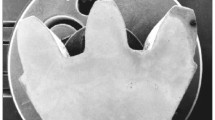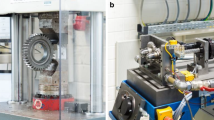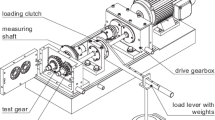Abstract
This paper discusses influences of the base material, pre-heat treatment and hardening pattern on the residual stresses of induction hardened gears with module 2 and 4 mm. The gears were hardened in a simultaneous dual frequency induction hardening process. After the hardening process, no peening was applied. Depending on the hardening pattern, base material and tempered condition, a wide range of residual stress profiles did occur, with the surface residual stresses reaching from compressive to tensile residual stresses at the tooth flank depending on the variant. In this paper, the main influence parameters on the residual stress profile will be identified.
Zusammenfassung
Dieses Paper diskutiert den Einflus von Grundwerkstoff, Vorvergütungszustand und Härtekontour auf den Eigenspannungszustand induktivgehärteter Zahnräder mit Modul 2 und 4 mm. Die Zahnräder wurden in einem Zweifrequenzverfahren induktiv gehärtet. Nach dem Härten wurde kein Strahlprozess durchgeführt. Ausgehend von Härtekontur, Grundwerkstoff und Vergütungszustand zeigte sich ein breites Spektrum an Eigenspannungsprofilen. Je nach Variante reichten dabei die Oberflächeneigenspannung von Druck- bis Zugeigenspannungen an der Zahnflanke. In diesem Paper wird der Haupteinflussparameter auf das Eigenspannungsprofil herausgearbeitet.










Similar content being viewed by others
References
Bretl N, Schurer S, Tobie T et al (2013) Investigations on tooth root bending strength of case hardened gears in the range of high cycle fatigue. AGMA 2013 Fall Technical Meeting, Indianapolis. AGMA, USA
Coupard D, Palin-luc T, Bristiel P et al (2008) Residual stresses in surface induction hardening of steels—Comparison between experiment and simulation. Mater Sci Eng A 487(1–2):328–339
Dobler F, Tobie T, Stahl K et al (2016) Influence of hardening pattern, base material and residual stress condition on the tooth root bending strength of induction hardened gears. Proceedings of the International Conference on Power Transmissions.
Güntner C, Dobler F, Nadolski D et al (2017) Load carrying capacity of induction “contour“ hardened gears. Proceedings of the 5th International Conference on Steels in Cars and Trucks (SCT).
Höhn B‑R, Tobie T, Stenico A et al (2009) Influence of residual stresses on tooth root bending strength of case hardened gears (gear strength and durability, including gear materials and heat treatment techniques). The Proceedings of the JSME international conference on motion and power transmissions, pp 333–337 (Heft: 0)
Holmberg J, Steuwer A, Stormvinter A et al (2016) Residual stress state in an induction hardened steel bar determined by synchrotron- and neutron diffraction compared to results from lab-XRD. Mater Sci Eng A 667:199–207
König J, Koller P, Tobie T et al (2017) Influence of additional surface finishing to the material properties and the flank load carrying capacity of case-hardened gears with grinding burn. The JSME International Conference on Motion and Power Transmissions.
Nadolski D, Dobler F (2016) FVA-Nr. 660/I – Heft 1186 – Induktionshärtung – Tragfähigkeit und Festigkeitseigenschaften induktionsgehärteter Zahnräder.
Rodman D, Krause C, Nürnberger F et al (2011) Induction Hardening of Spur Gearwheels Made from 42CrMo4 Hardening and Tempering Steel by Employing Spray Cooling. Steel Res Int 82(4):329–336
Savaria V, Bridier F, Bocher P (2016) Predicting the effects of material properties gradient and residual stresses on the bending fatigue strength of induction hardened aeronautical gears. Int J Fatigue 85:70–84
Schwenk M, Kaufmann B, Hoffmeister J et al (2012) Residual Stress Prediction for Dual Frequency Induction Hardening considering Transformation Plasticity during Austenitization. Quenching Control and Distortion, pp 45–56
Winkler KJ, Schurer S, Tobie T et al (2018) Investigations on the Tooth Root Bending Strength and the Fatigue Fracture Characteristics of Case Carburized and Shot Peened Gears of Different Sizes. International Gear Conference, Lyon
Acknowledgements
The presented research work was sponsored by the “Arbeitsgemeinschaft industrieller Forschungsvereinigungen e. V. (AiF)”, by funds of the Bundesministerium für Wirtschaft (BMWi, IGF no. 16866 N) and with an equity ratio by the “Forschungsvereinigung Antriebstechnik e. V. (FVA)”. The results shown in this work were taken from results of the research project FVA 660 “Induktionshärtung”. More detailed information is given in the final report [8].
Author information
Authors and Affiliations
Corresponding author
Rights and permissions
About this article
Cite this article
Cermak, H., Dobler, F., Nadolski, D. et al. Influence of base material, tempered condition and hardening pattern on the residual stress profile of induction hardened gears. Forsch Ingenieurwes 83, 571–577 (2019). https://doi.org/10.1007/s10010-019-00341-w
Received:
Revised:
Accepted:
Published:
Issue Date:
DOI: https://doi.org/10.1007/s10010-019-00341-w




